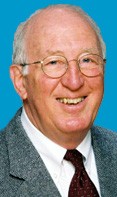Contact: Osler McCarthy, staff attorney for public information
512.463.1441 or click for email
June 23, 2008
MISTER JUSTICE BAKER, 1931-2008: A TRIBUTE

Two weeks ago when Austin visitors came to check on former Justice James A. Baker, he smiled when he was told he looked good. His face was drawn, his frame a fraction of what it was only months before.
“That’s kind of you, Mr. McCarthy,” he said.
He called everyone by name with a courtesy title around the Court. Everyone.
Mr. Justice Baker was not so much a throwback to Southern gentility. He was born in Indiana, after all, although reared in Dallas. But Jim Baker – his lifelong friends called him Jaime, or Jaim for short – was courteous. More than anything to his friends and colleagues, he was gracious
He also was devoted to the law and fiercely independent as a judge.
He died Sunday. He was 77, and much too young.
“Justice Baker was one of a kind,” Chief Justice Wallace B. Jefferson said, “a gentleman, a scholar, a man of deep faith. He was principled and compassionate in his work – and was entirely devoted to his wife, Clauda. The State of Texas was fortunate to have such a loyal public servant. The entire Court family mourns his loss.”
Services will be at 1 p.m. Wednesday at Highland Park Presbyterian Church, 3821 University Blvd. in Dallas. Besides his wife, he leaves two daughters, Carroll Moore of Dallas and Catherine Lassetter of Houston, and three grandchildren.
Texas appellate lawyers knew him, on the Court and off, at his steadfast position in the third or fourth row at almost every continuing legal education seminar on appeals.
In the days when he was helping make Texas law, he was there to study it.
In the days after he retired from the Court, he was there to study it.
James A. Baker was appointed to the Court by then-Gov. George W. Bush in 1995 after more than eight years on the Fifth District Court of Appeals in Dallas. He kept his Supreme Court seat in 1996 and retired August 31, 2002, in large part because, if he had run for re-election, he would have reached mandatory retirement age midway through his second term.
Eligible to retire, then, he instead joined what was Dallas law firm Hughes & Luce LLP (now K&L Gates) as head of its appellate practice group. Even after his cancer diagnosis last year, and even after the cancer crept through his body, his lungs, his legs, his spine, Mr. Justice Baker went to work.
“Jim Baker was a judge’s judge,” retired Chief Justice Tom Phillips said. “He was dedicated, hard-working, and eminently fair. He set a high standard for his own work ethic and expected it from his colleagues as well.
“We invented a verb at the Court for what happened to the opinion drafts that each justice would circulate to the other justices for comment – they would come back ‘Bakerized’ – covered with suggested rewrites, expositions on Texas law and organizational critiques – all in precise, red-ink block printing.”
He railed against unnecessary prepositional phrases and other common devices of the writer working on content perhaps at the expense of brevity and clarity.
But as a justice he was much more than a grammar stickler.
“He was what a judge should be,” said former Justice Deborah Hankinson.
“He decided cases as they should be decided, on the record and never from an agenda, politics or for special interests. He was principled and played by the rules. He inspired confidence in the courts because of that.”
Justice Baker graduated from Highland Park High School (named distinguished alumnus in 1998) and from Southern Methodist University (class of 1953) and SMU Law School (’58, distinguished alumnus 2004).
He was a name partner in two Dallas firms from the time he graduated from law school until he founded the Law Office of James A. Baker in 1979. He was elected to the Fifth Court of Appeals in 1986 and served on it from 1987 to October 3, 1995, when he joined the Texas Supreme Court.
Perhaps his greatest advocacy was in his strict adherence to standards for mandamus and appellate review, Justice Hankinson said. “He believed people needed to have standards and they should be applied to all....
“He thought those words meant something and people were entitled to have them applied fairly.”
When he began his Court tenure in 1995, he began calling his executive assistant, Linda Smith, Mrs. Smith.
Of course.
He was formal, but hardly stiff.
“No one here had ever called me Mrs. Smith,” she said. “Because communication was easy, I assured him that Linda was all right and at the Court all the staff used first names, except in respect to the justices. But he never varied, continuing to address me as Mrs. Smith.”
Mrs. Smith became a friend and part of his family, as did so many on the Court, especially his law clerks and staff attorneys. “Several weeks passed and he related a story that he and ‘Mrs. Baker’ shared, continually referred to her as Mrs. Baker. If ‘Mr. Justice Baker’ called his wife of several decades Mrs. Baker, there was no chance I would become Linda.”
He swore in Deputy Clerk Jessica Hamby when she began with the Court in 2001, working two floors below the justices’ chambers and often out of their perspective. “Even after he left the Court and he would stop by for a visit or to drop something off, he would always remember who I was. He was a kind soul.”
His last day in his Dallas office was Friday. Doctors had determined the experimental cancer treatment was not working.
Mr. Justice Baker died in his sleep Sunday afternoon.